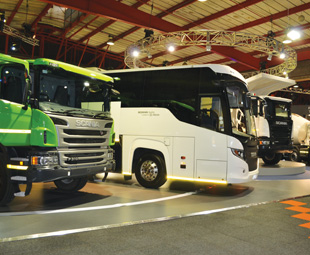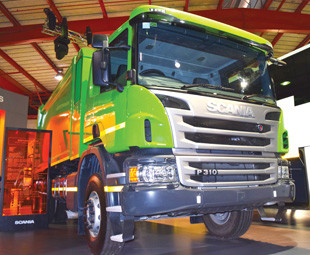Sustainability and connectivity to the fore!

Scania’s stand at Futuroad centred around the complete sustainable transport solution that the company offers. CHARLEEN CLARKE caught up with three men at the helm of the company during the exhibition, and discovered that, thanks to advances in sustainability and connectivity, transport as we know it is about to change
Aparadigm shift is happening in transport – and it’s all thanks to sustainability and connectivity, two issues that are extremely high on the Scania agenda. Raimo Lehtiö, MD of Scania South Africa, says the company is doing everything within its power to promote sustainability.
Lehtiö says that northern Mozambique holds considerable potential when it comes to gas-powered vehicles. “Ships could also be powered by gas in the not-too-distant future. “There are many huge container ships on our seas. They are massive vessels, transporting 15 000 containers. They are heavy polluters – the emissions of 15 of these vessels equate to those of 750-million passenger cars! As such, powering these ships by gas will be exceptionally good news for our environment,” Lehtiö points out.
 Of course, as Alexander Taftman, GM product and marketing at Scania, notes, sustainability is about more than just alternative fuels. “Sustainability is a three-pillar model, which creates mutual benefits for people, planet and profit. This is based on the premise of commitment from Scania towards contributing to a viable commercial proposition, based on smart and safe transport, energy efficiency and alternative fuels/electrification,” he says.
Of course, as Alexander Taftman, GM product and marketing at Scania, notes, sustainability is about more than just alternative fuels. “Sustainability is a three-pillar model, which creates mutual benefits for people, planet and profit. This is based on the premise of commitment from Scania towards contributing to a viable commercial proposition, based on smart and safe transport, energy efficiency and alternative fuels/electrification,” he says.
Taftman points out that sustainability contributes to customers’ revenue streams. “In considering alternative fuel sources to traditional diesel, we can see that vehicles running on locally produced gas have a lower fuel cost per kilometre driven. This lowers operational costs, which contributes to customers’ revenue streams.”
As such, Scania is driving the shift towards a sustainable transport system, which allows sustainability and connectivity to work hand in hand. “We want to create a world of mobility that is better for business, society and the environment. These technologies have already started to show great value for operators when it comes to risk control and operating revenues,” says Taftman.
Scania’s vision is to be the leader in the shift to sustainable transport solutions, but Taftman says this is about much more than changing to gas or biodiesel-powered vehicles. “In order to live the sustainability dream, we must move to the next level,” he points out.
 This is where connectivity comes into play. “The two subjects are inextricably linked,” Taftman notes. “Connectivity is evolving at a rapid pace. The vehicle of the future won’t only be able to connect with the driver and owner, it will also be able to connect and communicate with other vehicles. We will be looking at an integrated transport grid – with the truck being one essential part of that grid.”
This is where connectivity comes into play. “The two subjects are inextricably linked,” Taftman notes. “Connectivity is evolving at a rapid pace. The vehicle of the future won’t only be able to connect with the driver and owner, it will also be able to connect and communicate with other vehicles. We will be looking at an integrated transport grid – with the truck being one essential part of that grid.”
Connectivity could have a major impact on congestion. “As we all know, congestion is a major source of waste. We all sit in traffic every day, but imagine if all vehicles in the grid could speak to each other. They would be able to direct the flow of traffic, making it as lean and as safe as possible. The infrastructure would be far better utilised.
“Thanks to connectivity, we will be able to eliminate, or avoid, waste in the transport system. This will have an extremely positive impact on cost, transport flow and the wellbeing of people. People also suffer because of pollution and stress,” Taftman points out.
Mark Erasmus, GM service at Scania, agrees. “The world of transport is changing. Thanks to advances in connectivity, the truck of the future will ‘talk’ to the workshop. If a truck breaks down, the driver won’t need to telephone his manager or a workshop.
 “He also won’t need to surmise as to the cause of the breakdown either. The truck will do all that itself. In fact, the workshop or call centre will know about a breakdown before the owner of the transport company,” he predicts.
“He also won’t need to surmise as to the cause of the breakdown either. The truck will do all that itself. In fact, the workshop or call centre will know about a breakdown before the owner of the transport company,” he predicts.
As more and more data becomes available to truck manufacturers, they will be able to serve their customers better. “Going forward, we will be thinking in new and different ways. We will have access to a huge pond of data. It’s all about fishing in that pond, getting the right data and using it appropriately. Connectivity will help us to serve customers better – because we will have better access to information. As such, we will be able to produce tailor-made packages for customers,” says Lehtiö.
While we have already seen massive advances in connectivity, Erasmus believes truck manufacturers are only scraping the tip of the telematics iceberg. “We have already achieved so much with telematics, but I believe that this field is still in its infancy. What’s coming is going to be even more exciting.
“Telematics already measures the hard stuff (fuel consumption, for instance). In future, it will measure the soft stuff, too – such as weather conditions and the prevalence of dust (and its impact on the engine), for instance. Trucks will become more self aware; their behaviour will almost mimic that of a human,” he believes.
Taftman notes that these predictions may sound far-fetched, but, in fact, they’re not. “This may sound like science fiction, but it will be reality one day,” he stresses.
Erasmus agrees. “Today’s science fiction is tomorrow’s reality. “There are no limits to what our industry – and Scania specifically – can achieve,” he maintains.
It sounds as though operators have a lot to look forward to!
Published by
Focus on Transport
focusmagsa



